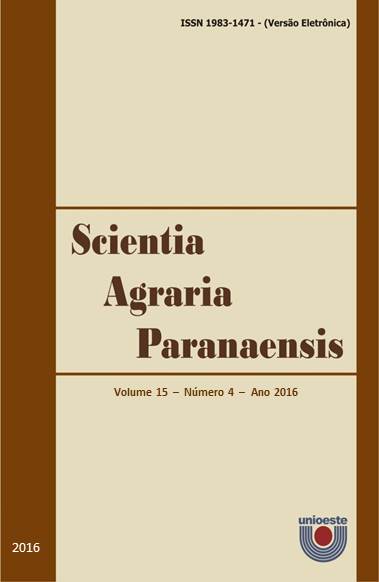Seed germination and early growth of physic nut seedlings under salinity stress
DOI:
https://doi.org/10.18188/sap.v15i4.12405Keywords:
Jatropha curcas, osmotic stress, salt stress.Abstract
Soil salinity is one of the major abiotic stresses that limit seed germination and plant growth, causing yield loss in crop species. The phytotoxic effects of salt stress on seed germination and early growth of physic nut (Jatropha curcas L.) seedlings were investigated in the present study. Physic nut seeds were subjected to five levels of salinity [0 (control); 25; 50; 75 and 100 mmol L-1 of NaCl], using the solution-paper method, with five replications. The experimental unit consisted in a germitest paper roll with 25 physic nut seeds. Salt treatments were evaluated based on the following tests: first count of germination test (7 days), total germination (12 days) and early growth of physic nut seedlings (12 days). Results showed that the addition of 100 mmol L-1 of NaCl reduced the first count of germination test (45%), total germination (50%), shoot length (42%), root length (59%), shoot dry matter (34%) and root dry matter (44%) of physic nut seedlings compared to the NaCl-free control. The exposure to high salt concentrations severely restricted the seed germination and early growth of physic nut seedlings. These data suggest that physic nut crop is a moderately sensitive species to high salinity levels during the stage of seed germination and early seedling growth.Downloads
Published
07-12-2016
How to Cite
OLIVEIRA, B. L. N. de; STEINER, F.; HONDA, G. B.; MACHADO, J. S. Seed germination and early growth of physic nut seedlings under salinity stress. Scientia Agraria Paranaensis, [S. l.], v. 15, n. 4, p. 416–420, 2016. DOI: 10.18188/sap.v15i4.12405. Disponível em: https://e-revista.unioeste.br/index.php/scientiaagraria/article/view/12405. Acesso em: 31 may. 2025.
Issue
Section
Scientific Article
License
Aviso de Direito Autoral Creative Commons
Política para Periódicos de Acesso Livre
Autores que publicam nesta revista concordam com os seguintes termos:
1. Autores mantém os direitos autorais e concedem à revista o direito de primeira publicação, com o trabalho simultaneamente licenciado sob a Licença Creative Commons Attribution que permite o compartilhamento do trabalho com reconhecimento da autoria e publicação inicial nesta revista.2. Autores têm autorização para assumir contratos adicionais separadamente, para distribuição não-exclusiva da versão do trabalho publicada nesta revista (ex.: publicar em repositório institucional ou como capítulo de livro), com reconhecimento de autoria e publicação inicial nesta revista.
3. Autores têm permissão e são estimulados a publicar e distribuir seu trabalho online (ex.: em repositórios institucionais ou na sua página pessoal) a qualquer ponto antes ou durante o processo editorial, já que isso pode gerar alterações produtivas, bem como aumentar o impacto e a citação do trabalho publicado (Veja O Efeito do Acesso Livre).
Licença Creative Commons
Esta obra está licenciada com uma Licença Creative Commons Atribuição-NãoComercial-CompartilhaIgual 4.0 Internacional, o que permite compartilhar, copiar, distribuir, exibir, reproduzir, a totalidade ou partes desde que não tenha objetivo comercial e sejam citados os autores e a fonte.


